In this post we’ll look at the best psoas stretches and when you should not stretch.
Should I do a psoas stretch?
Most of us sit all day and our bodies slowly adapt to it. As a result, the psoas and other hip flexors shorten and get tight.
So the best way of action would be stretching right?
Unfortunately, it’s not always that easy, as you have to check for strength of the psoas before doing a psoas stretch.
Checking for strength of the psoas
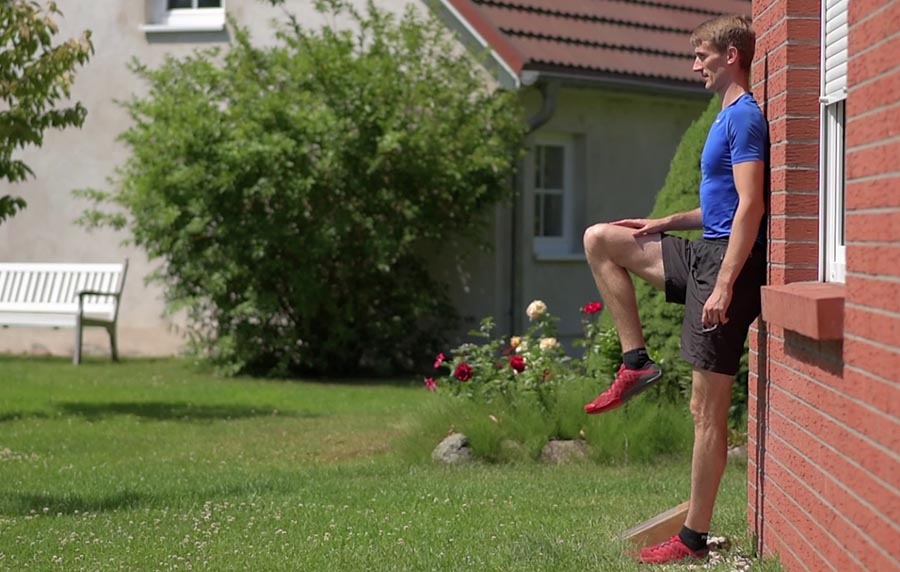
Here is one simple way to check whether your psoas is strong or not.
With your back to a wall, you stand on one foot while elevating the knee of the other leg to above hip level (demonstrated without the wall in the picture). The foot can be a couple of inches away from the wall.
If you can hold this position for 30 seconds, your hip flexors are not likely to be weak. By doing this drill without the wall you can also check proprioception, vestibular function and gluteal strength.
You will need to squeeze the glute of the supporting leg hard to maintain proper posture.
Should your hip flexors test weak, you will have to perform a strengthening exercise right after your psoas stretch. To do that you can just do the test again. Concentrate on perfect technique and posture.
Before Sstretching
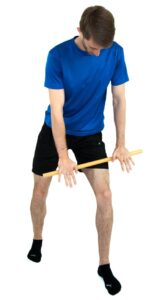 The nervous system will stop you from stretching a muscle too far if it perceives the position of the limbs as a threat to your health.
The nervous system will stop you from stretching a muscle too far if it perceives the position of the limbs as a threat to your health.
If you aren’t properly warmed up your nervous system will limit your flexibility even further, making stretching a lot more difficult. This is why you need to do at least a couple minutes of light exercise before stretching.
If you do something as simple as some squats and lunges, you will be a lot better off than if you were to do nothing.
Next up, you will have to take care of soft-tissue restrictions as best as you can. You can use a foam roller or a simple stick.
The Psoas is a muscle that is difficult to reach and if you have trigger points in there you could really benefit from having a physical therapist work on the muscle.
The Couch Stretch
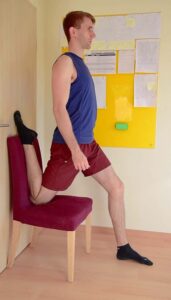
The couch stretch is a combined stretch for the hip flexors and the quadriceps muscles. I’ve recorded a video demonstration of it here (skip to 05:00 in the video):
You can find other great leg stretches in the article about patellar tendonitis stretches.
The Most Popular Psoas Stretch

This psoas stretch is probably the most popular version out there.
To perform it, you get down in a lunge position with your knee on the ground. Use something for cushioning like a blanket or a pillow.
Now squeeze the glute of the rear leg and imagine driving the knee back and into the ground, while having the hip sink down and forward.
Brace your abs, as if you’re bracing for a punch. Don’t let your abs protrude outwards, but work to stabilize your pelvis with your core musculature. Don’t let the pelvis tilt forward.
Personally, I prefer moving my rear leg back as I go deeper into the stretch, but you can also keep both feet stationary and just let the hip sink down and forward. Remember the following cues though:
- Keep your back straight and vertical
- Keep your hips squared up
- Keep the glute of the working leg tight
In other words: you must not lean forward or tilt your hip to the side or let your back round.
You can place one hand at the lower back, so that you can tell how well you’re contracting the glute and whether your back is rounding.
Psoas Stretch with a stick
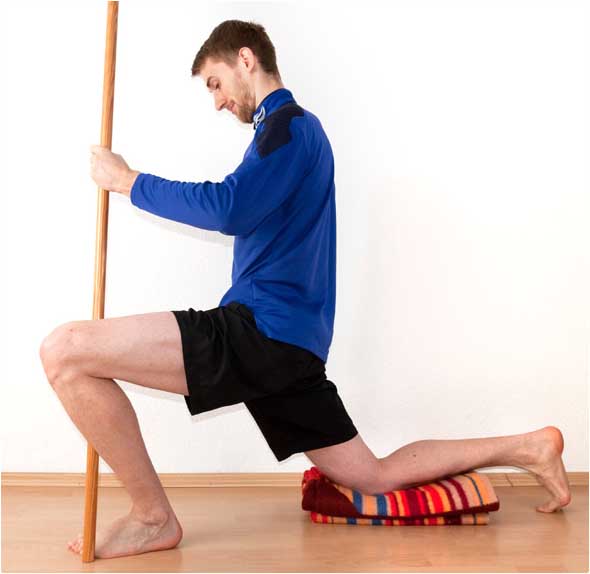
With this stretch you deal with your psoas while improving ankle mobility. Two birds with one stone.
To perform it, you just place a stick on the outside of your little toe and move the knee past the stick on the outside (this prevents the arch of your foot from collapsing).
As you go deeper into the stretch you move your knee further past the stick. Don’t force the range of motion and keep your heel on the ground.
Remember to squeeze your glutes and brace your abs with this one as well.
Combined Psoas & Quadriceps Stretch
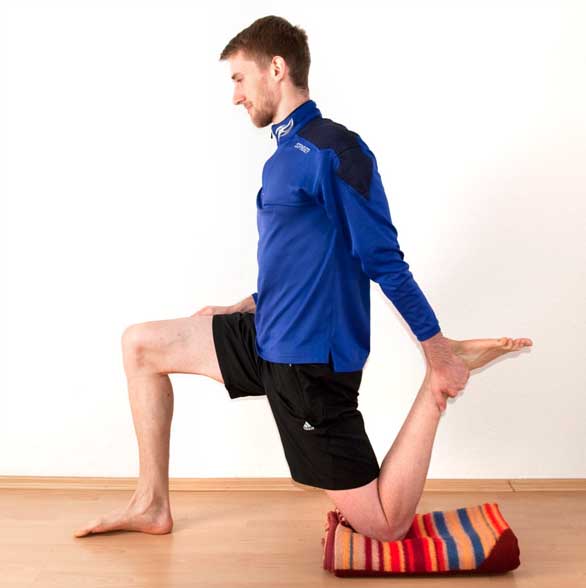
In this advanced psoas stretch you’ll not only be stretching the psoas, but the quadriceps as well. From the familiar lunge position you grab the ankle of the rear leg and pull it up towards you.
Maintain a straight and vertical back. Don’t let your hip tilt forward.
There are more muscles pulling on your hip in this psoas stretch, so really be sure to squeeze your glutes hard and keep your abs braced.
The more you squeeze the glute of the working leg, the more that hip flexor has to relax, because of what’s called reciprocal inhibition (i.e. the antagonist of a muscle you’re using has to relax).
Experiment with the setup for this stretch to find something that’s comfortable.
I prefer getting into the lunge position, grabbing my ankle and then bending forward, lifting my rear knee into the air.
Once bent forward, I place the rear knee on the ground and roll back into upright position. It may sound weird, but I found this to be the most “comfortable” way to get into the movement.
Myofascial psoas stretch #1

For this advanced variation, which I found in one of Dr. Perry Nickelston’s excellent blog posts, you will need a rope with some handles or a rubber band.
If you have a sling trainer or some athletic rings that’s great. If you don’t have these tools, you can improvise a setup using rubber bands or something similar.
Set up with your hands inside the rings and have your hands face each other and slightly in front of your shoulders.
Now for 9 repetitions you take a step forward, squeezing the buttocks muscles and extending your arms overhead, with the rings/rope/handles on the ridges of your hands.
Exhale as you go forward and into the end position (frame 2). After holding the end position for 2 seconds you go back to the starting position.
With each repetition you should step forward a bit further and go a little deeper into the stretch.
On the tenth repetition you turn your hands so that your palms face forward and as you step forward you bend your palms backwards, effectively stretching to fascial line on the front of the body (see the picture for clarification).
Hold this position for 30 seconds, but don’t hold your breath. Here are some cues for this psoas stretch:
- Exhale as you step forward, inhale as you go back
- Pay attention to hand placement
- Squeeze your mid-back (pull your shoulder blades together)
- Don’t hold your breath
- Don’t turn your back foot in
If you want to see a video demonstration or know more about the scientific background for this psoas stretch, you can watch Dr. Perry’s Psoas Stretch video.
ATG Split Squat
A final psoas stretch I want to share is the ATG split squat.
This is a strengthening exercise as much as it is a split squat. You can watch the video demonstration below to learn more:
